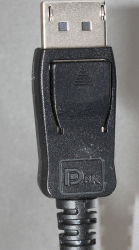New monitor DisplayPort trouble: Flickering / Blackout
Sunday, April 28. 2024
I spend lot of time doing stuff with a computer or computers to be exact. As a heavy-duty user, I love to have good displays to do the computing with. As every thing in consumer electronics, also monitor technology has improved a lot.
One of these days, I wanted a new monitor with really good spec.
Delivery guy brought me one, I installed it into my VESA monitor arm and then everything turned sour.
My expensive monitor "kinda" worked. Picture was there, it was crisp, backlight was really good, HDR-colors were really vivid until the monitor chose to flicker a bit and black out. This unfortunate blackout was a totally random event. It could occur three times per minute, or alternatively there could easily be 20 minutes without problems. Such random problems are very difficult to troubleshoot. In any easy case, reproducability is the key. No such joy here.
When in doubt - Google the problem!
Obviously, I went online with a description of the symptoms. Quite soon, this is what I found from Reddit: I'm having screen flickering/blackout via Displayport on my new 1440p 144 hz monitor. The suggestions pointed towards testing different cables and discussion about DisplayPort versions. Good ideas!
GPU
From GPU spec:

Confirmed GPU DisplayPort to be at version 1.4.
Previous Monitor
Spec says:

Confirmed old monitor DisplayPort to be at version 1.2. Hm. Everything worked at 4K resolution, no 144Hz though.
New Monitor
Spec:

Confirmed monitor DisplayPort to be at version 1.4. Equal to GPU.
Maybe the problem IS with the cable as suggested in Reddit!
Theory: DisplayPort Cable
Doing research on DisplayPort: DisplayPort 1.4 vs. 1.2: What's the Difference?
DisplayPort 1.2, originally released in 2010, offers more bandwidth than all but the latest HDMI standards.
DisplayPort 1.4 is a much more capable standard, with limited competition from even the latest and greatest
DisplayPort 1.4 supports resolutions of up to 8K at 60Hz or 4K at 240Hz
DisplayPort 1.2 supports resolutions of up to 4K at 60Hz
Doing research on cabling: How to Tell the Difference Between Display Port 1.2 and 1.4 Cables
Just to be clear, DisplayPort cables are not classified by version, they are classified by the amount of bandwidth they can handle.
Good thing there was a DisplayPort cable with the monitor. Changed it into use and oh yes! Flickering was gone.
Wikipedia says in DisplayPort -article:
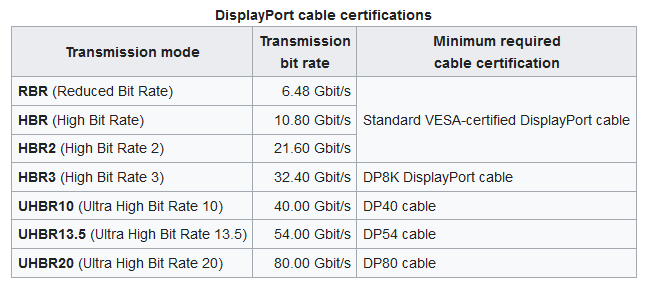
There are seven (7) different specs for a cable. Well, that's a surprise.
Practice: DisplayPort Cable
Let's look at those cables bit closer. This is the non-functioning one:
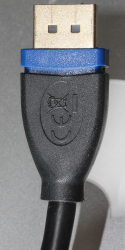
There are zero clues on cable spec. Nothing! It has WEEE label and CE marking, that's all. Given reality, I'm guessing it is HBR / HBR2 -spec.
Still no idea of cable details. DisplayPort-logo with 8K suggests spec to be at least HBR3.
Reality Check
There is really no way of telling how fast a DisplayPort-cable is by hooking it into a computer or eyeballing it.
Beware: Most DisplayPort cables aren't sold with correct information
Aow come on! This is horrible. ![]()
Good thing is my money wasn't wasted on a faulty unit.
On VAT Calculation / Rounding Monetary Values
Thursday, April 18. 2024
Yesterday API design was hard, today creating invoice line items with VAT on them is hard.
When calculating taxes on items, a very careful approach must be taken on rounding. Line items of an invoice need to be stand-alone units and special care must be taken when calculating sum of rounded values. For unaware developer, this could be trickier than expected.
Products
I'll demonstrate the problem with a ficticous invoice. Let's say I have five different products to sell with following unit prices:
- Product 1 1.24 €
- Product 2 2.77 €
- Product 3 3.31 €
- Product 4 4.01 €
- Product 5 5.12 €
Example invoice #1
A happy customer bought ten of Product 1. Following invoice could be generated from the transaction:

Rather trivial arithmetic with value added tax being 24% can be made. 10 units costing 1,24€ each will total 12,40€. Adding 24% tax on them will result VAT amount of 2,976€. As €-cents really needs to be between 0 and 99 rounding is needed on total amount. Minor numeric cruelty will be needed to make result feasible as money. That's ok. The end result is correct and everybody are happy.
Example invoice #2
Second happy customer bought same as the first customer and additionally 14 of Product 2. Following invoice could be generated from the transaction:

Looking at columns total and total rounded reveal the unpleasant surprise. If rounding is done once, after sum, the rounded value isn't 63,47 as expected. When rounding the total sum into two decimals 63,4632 will result 63,46. There is a cent missing! Where did it go? Or ... alternatively, where did the extra cent appear into total rounded column?
Example invoice #3
Let's escalate. A really good customer bought everything. Lots of everything. Invoice will look like this:
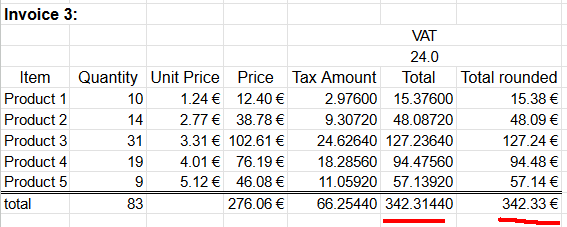
Whoooo! It escalates. Now we're missing two cents already. Total sum of 342,3144€ will round down to 342,31€.
Lesson Learned
Doing one rounding at the end is mathematically sound. Arithmetic really works like that. However, when working with money, there are additional constraints. Each line needs to be real and could be a separate invoice. Because this constraint, we're rounding on each line. Calculating sum of rounding stops making sense mathematically.
Please note, these numbers were semi-randomly selected to demonstrate the problem. In real world scenario roundings can easily cancel each other and detecting this problem will be much more difficult.
Modeling real-world into computer software is surprisingly tricky.
- Anonymous
On API design
Wednesday, April 17. 2024
API design is hard.
If your software makes the behavior hard to change, your software thwarts the very reason that software exists.
- Robert C. Martin
ref. Sandia LabNews on February 14, 2019
What happens when in a design meeting, you're sure that a thing will NEVER happen? Until it does!
What if you were adamant, a value added tax percentage will NEVER be anything else than an integer? Until it does!
From news on 16th Apr 2024: Reports: Finnish government to raise general value-added tax rate to 25.5%
Meanwhile...
At Paytrail API (https://docs.paytrail.com/#/):
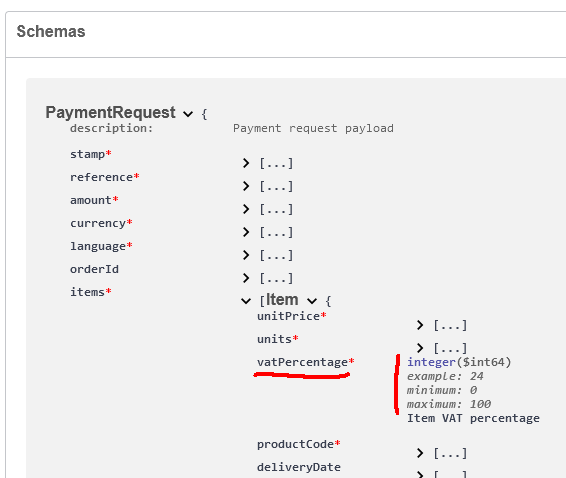
At Visma Netvisor API (https://support.netvisor.fi/en/support/solutions/articles/77000554152-import-sales-invoice-or-order-salesinvoice-nv):

I don't think there is much to do. You take yout your humility hat and start eating the bitter oat porridge to get the thing fixed.
Btw. thanks to Afterdawn on bringing this to our attention.
Bottom line: It shouldn't be too hard to figure out what politicians do. They don't think rational (thoughts nor numbers).
Examples from France and Monaco (VAT rates 20%, 10%, 5.5%, 2.1%), Ireland (VAT rates 23%, 13.5%, 9%, 4.8%), Liechtenstein (VAT rates 8.1%, 2.6%, 3.8%), Slovenia (VAT rates 22%, 9.5%, 5%) or Switzerland (VAT 8.1%, 2.6%, 3.8%).
